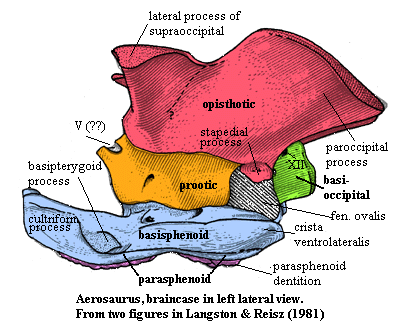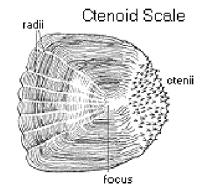
| Palaeos: |  |
Glossary |
| The Vertebrates | Cr-Cz |
| Page Back | Unit Back | Unit Home | Unit Dendrogram | Unit References | Glossary | Taxon Index |
| Page Next | Unit Next | Vertebrates Home | Vertebrate Dendrograms | Vertebrate References | Bones | Timescale |
For most phrases beginning with directional words, e.g. "posterior," "dorsal," "external," etc., or some generic anatomical terms, e.g., "vena," look under the next word in the phrase. However, note that this convention is not used with complete consistency in this Glossary.
 Craniostyly: a type of jaw suspension
characteristic of mammals in which the lower jaw is supported by
the squamosal or by the squamosal region of the fused skull.
Craniostyly: a type of jaw suspension
characteristic of mammals in which the lower jaw is supported by
the squamosal or by the squamosal region of the fused skull.
Crato Formation: Early Cretaceous II (Aptian) of northeastern Brazil. Freshwater?
Crenulate (or crenulated): having a margin which is finely notched, scalloped, embayed, or incised in a regular pattern (not just randomly eroded). Examples might include the stellate ornamentation of the gold paper seal on a high school diploma or the wavy lateral margins of a store-bought cupcake -- both designed to impart a sense of importance and refinement to an otherwise and unfulfilling product.
Crepescular: active during "half-light" hours, dawn or sunset.
Cretaceous: (K) the last period of the Mesozoic Era, from 144-65 Mya. The Early Cretaceous I includes the Berriasian, Valanginian, Hauterivian, and Barremian, Ages. The Early Cretaceous II covers the Aptian and Albian Ages (144-99 Mya). The Late Cretaceous is made up of the Cenomanian, Turonian, Coniacian, Santonian, Campanian, and Maastrichtian Ages (99-65 Mya).
Cribriform L cribrum = a sieve, and forma = form. Applied to the sieve-like plate of the ethmoid bone.
Crista: L. crista = a crest, as on a cock or helmet; a ridge. For one specialized use, see Molars.
Crista galli: the dorsal continuation of the perpendicular plate of the ethmoid. The crista galli can be envisioned as a thin sheet of bone oriented straight up and down. It splits the ethmoid in two lengthwise and rises into the brain where it may partially separate the hemispheres of the mammalian brain.
Crista interfenestralis: a ridge of bone that divides the inner ear of many reptiles into two parts. The anterior part contains the fenestra ovalis and seems to be analogous to the scala vestibuli recess and is referred to by that name. The posterior part is analogous to the recess for the scala tympani and is sometimes called by that name.
 Crista
muscularis: of the parasphenoid, a shelf, or pair of shelves on
the posterior end of the parasphenoid. This crista is associated with the m.
rectus capitis, apparently involved in moving the head on the occiput.
The crista muscularis is shown in red in the image at right.
Crista
muscularis: of the parasphenoid, a shelf, or pair of shelves on
the posterior end of the parasphenoid. This crista is associated with the m.
rectus capitis, apparently involved in moving the head on the occiput.
The crista muscularis is shown in red in the image at right.
Crista obliqua: see oblique ridge.
Crista parotica: seems to be the same as the crista prootica. However, since this lateral ridge of the otic capsule is frequently formed by the opisthotic, rather than the prootic, this may be a better name.
Crista prootica: a ledge or ridge which elaborates the dorsal surface of the prootic or, more generally, the roof of the otic capsule, laterally. The crista may extend posteriorly & laterally, continuous with the paroccipital process, and/or anteriorly or anteroventrally to protect cranial nerve foramina and form part of the fenestra ovalis/vestibuli. In basal tetrapodomorphs and tetrapods, the crista prootica forms the floor of the posttemporal fenestra. See The Prootic. In many tetrapods, the crista prootica is not ossified, or incompletely ossified. However, in frogs, the crista is the main strut joining the skull roofing bones (frontoparietals) with the squamosals. The crista prootica has a similarly expanded role in mammals where it forms an important part of the epitympanic recess and anchors the tympanohyal.
 Crista ventrolateralis: The spelling is suspicious, but follows
Langston &
Reisz (1981). Apparently, ventrolateral ridges on the
braincase formed by the lateral edges of the parasphenoid and
basisphenoid.
Crista ventrolateralis: The spelling is suspicious, but follows
Langston &
Reisz (1981). Apparently, ventrolateral ridges on the
braincase formed by the lateral edges of the parasphenoid and
basisphenoid.
Crista vestibuli: a bone ridge which partially walls off the lagena (or cochlea) from the rest of the vestibular apparatus. Similar structures by this name have evolved at least twice (crocs and mammals) presumably to improve the efficiency of the lagenar hearing apparatus.
Crochet: in mammalian dentition, a hook-like branch from a molar loph. See image at lophodont.
Crocodile normal tarsus: a phrase usually ascribed to Chatterjee (1982). It refers to the type of archosaur ankle in which the joint passes between the astragalus and calcaneum. In the croc-normal joint, the ball is on the astragalus, and the socket is on the calcaneum, which acts mechanically as a part of the foot.
Crop: a bilobed cecum (blind diverticulum) of the esophagus, characteristic of certain birds.
Crown Group: [1] a clade defined in terms of living organisms. (Example: crown group archosaurs are the last common ancestor of living birds and crocodiles and all of its descendants); [2] any clade defined in terms of "the last common ancestor of species X and species Y and all of its descendants."
Cruropatagium: a wing membrane stretched between the legs.
Crurotarsal joint: an ankle joint that passes between the astragalus and calcaneum, as in crocodiles. Compare mesotarsal.
Crus: L. crista = leg. [1] Any structure in anatomy resembling a leg or, in the plural crura, of a pair of dividing structures; more often [2] the shin, i.e., the tibia & fibula.
Crus communis: the point in the vestibular apparatus where the semicircular canals meet. The corresponding bony compartment is the sinus superior utriculi.
 Ctenoid: a type of fish scale.
Thin, flexible, and overlapping. The posterior edge has comb-like teeth
which are believed to reduce drag during swimming. See Cycloid
and Ctenoid Scales.
Ctenoid: a type of fish scale.
Thin, flexible, and overlapping. The posterior edge has comb-like teeth
which are believed to reduce drag during swimming. See Cycloid
and Ctenoid Scales.
Cuboid: one of the distal tarsals, also referred to as the "fourth tarsal" in non-mammals. The cuboid normally articulates with the calcaneum and the proximal ends of metatarsals IV & V. See figure at Protocetidae.
Cuboidal: (of a cell layer) made up of round or cube-shaped cells, as opposed to squamous or columnar.
Cuifengshan formation: Early Devonian exposure in Yunnan, China (South China Province). Young & Zhang (1996).
Culmen: in birds, the upper bill between the distal nares and the tip of the bill. More generically, a ridge or summit; often the upper ridge of the maxilla.
Cultriform: knife-shaped, blade-like.
Cultriform process: the extended process at the anterior end of the braincase. Normally, a process of the parasphenoid.
Cuneiform: [1] L. cuneus = a wedge, and forma = form. Anything wedge-shaped. Used in anatomy for wedge-shaped distal tarsals or carpals. [2] in mammalian osteology, one of the carpal bones, normally articulating distally with the unciform and proximally with the ulna & pisiform. See image at unciform.
Cupula: The gelatinous covering of a neuromast organ. See also, The Ear .
Cursorial: related to, or adapted for, running.
Cusp: of a tooth, a point.
Cutler Formation: Early Permian and possibly Late Carboniferous of Colorado, New Mexico, and Utah. "Polymict, poorly-sorted conglomerates and arkosic sandstones, usually trough-crossbedded, representing channel fills of a braided to anastomosed fluvial system, and overbank deposits of fine-grained sandstones, siltstones and claystones, and intercalated crevasse channel and splay deposits. Conglomerates contain abundant reworked caliche carbonate clasts." CUTLER FORMATION. "The Cutler Formation and stratigraphically equivalent parts of the Cedar Mesa Sandstone constitute deposits of an extensive alluvial-braidplain and aeolian sand-sea system which was active in the Colorado Plateau region of the western United States in the Early Permian. The region was situated on the western margin of the North American craton, between the equator and latitude 10 degrees north." Aeolian Module [former site]. Overlies Abo Reef. See Abo-Cutler Formation.
 Cycloid: a type of scale found in
fish. The cycloid scale is thin and essentially round. Cycloid scales grow
by concentric additions. In some species scales show growth rings, with
spring and summer rings well-separated, and little growth in winter. If
present, this allows age and growth rate to be estimated. See Cycloid
and Ctenoid Scales.
Cycloid: a type of scale found in
fish. The cycloid scale is thin and essentially round. Cycloid scales grow
by concentric additions. In some species scales show growth rings, with
spring and summer rings well-separated, and little growth in winter. If
present, this allows age and growth rate to be estimated. See Cycloid
and Ctenoid Scales.
Cyclomorial: a form of scale in which large, stout lepidomorial units are added anteriorly and light thin, elongated units are added posteriorly. The bases of the large lepidomorial units grow concentrically around the previously added bases and are partially fused. Zangerl (1981).
| Page Back | Unit Home | Page Top | Page Next |
checked ATW080125